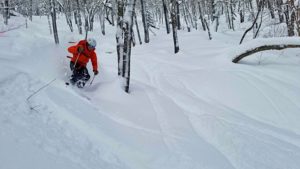
A Historic Moment For Backcountry Skiing in New Hampshire
A victory for public lands and skiers, the Forest Service decides to establish two zones that cater to backcountry skiing
For decades, New England’s clandestine culture of tree-cutting and glade-thinning has subsisted in the dark, heavily wooded alleyways. Most are small, discreet trimmings in secret stashes, though occasionally people get out of control and destroy entire hillsides, as when two men were arrested in 2007 for cutting down more than 800 trees on Big Jay, in Northern Vermont. But as backcountry skiing has grown in popularity in recent years, it’s become apparent that areas are needed to welcome the desires of skiers in a way that protects and respects natural habitat.
How The Granite Backcountry Alliance Is Fostering A Community of Like-Minded Skiers
According to the Decision Memo, the Civilian Conservation Corps had created as many as 68 backcountry ski trails across the greater White Mountain landscape at one time. Of those, 14 remain with many being within the boundaries of alpine ski areas. “The popularity of backcountry skiing is on the rise and the opportunities for this activity are limited,” the memo states. “Evidence of unauthorized vegetation removal to create skiable terrain has been observed in several areas on the White Mountain National Forest, including areas that provide important habitat for sensitive species. Although skiing is an allowable use on National Forest System lands, the unauthorized removal of vegetation is an illegal activity. In some instances, unauthorized vegetation removal has resulted in Forest Service response actions including area closures and investigations by law enforcement. Therefore, this project is needed to address public demand and protect forest resources.
“The purpose of the backcountry ski trail project is to provide high quality experiences in backcountry ski areas, while protecting wildlife habitat and other resources. In addition, the WMNF will work collaboratively with Granite Backcountry Alliance to promote partnerships and stewardship of public lands.”

Granite Backcountry Alliance, a New Hampshire nonprofit, was formed in 2016 to develop human-powered backcountry skiing opportunities in New Hampshire and western Maine. In a press release announcing the decision, Tyler Ray, GBA’s Granite Chief, said, “We commend the WMNF for recognizing the surge in skier demand for backcountry terrain and look forward to working with the National Forest on these projects and others in the future. Today’s decision marks a new-normal in how public lands are managed for glade skiing–through a thoughtful, transparent, and candid partnership. This decision will provide a significant boost to our community of backcountry skiers.”
Searching for Ski Bums and Tree Stashes at Stowe, Vermont, the East’s Fanciest Resort
Long-time skier and outdoors advocate United States Congresswoman Anne McLane Kuster, who provided support in connecting GBA and WMNF, added, “New Hampshire has some of the most interesting and challenging ski terrain in the East and expanding access to glade skiing is a great way to boost tourism and grow our outdoor recreation industry. This partnership between Granite Backcountry Alliance and the Forest Service brings a new and unique recreational outlet to the WMNF and will help support our economy and protect our forests. I was proud to support this effort and commend the hard work of everyone who has helped make this possible.”
Bartlett Mountain stands at 2,661 feet tall and was formerly the home of the Maple Villa Ski Trail, cut by the CCC in 1933. The trail descended two and a half miles and over 2,000 vertical feet. The initial popularity of the trail waned as the introduction of automated chairlifts became a more convenient option at nearby ski resorts. According to the Decision Memo, this 410-acre zone on Bartlett Mountain’s north-slope authorizes Granite Backcountry Alliance as the responsible entity for “vegetation removal, and installing and maintaining signs for the backcountry ski zones.” The Decision memo also authorizes development of up to 15 percent of the approved area as glade skiing terrain (with the balance remaining wild), with the revival of the Maple Villa Ski Trail as a main corridor for traveling uphill. The gladed ski terrain will follow a braided ski line design, where intersecting ski lines protect habitat and wildlife.

Baldface Mountain, located in New Hampshire just over the border from Maine in an area known as Evans Notch, will be a big draw for Maine skiers. The top of the authorized zone is known as “Baldface Knob,” standing at 3,025 feet tall and hosting a unique alpine zone. The authorized area for developing glade skiing terrain is 600 acres and the vertical drop is 2,500 feet to the bottom. “Baldface Knob will be a thrilling ski with its alpine and gladed terrain, uncommon conditions outside of New Hampshire’s Presidential Range,” Ray said. “It has the potential to be a classic glade, a slightly smaller scale yet modern version of Tuckerman Ravine flowing into the John Sherburne Ski Trail. We expect this zone to appeal broadly to all ability levels and incorporate an existing on-mountain lean-to. It also checks the box on trying to diffuse high traffic zones focused on Pinkham Notch, north of North Conway.”
GBA will host the 2nd Annual Wild Corn Shindig on Saturday, April 7th, at Black Mountain in Jackson, New Hampshire. All proceeds benefit Granite Backcountry Alliance and its many projects, including the Bartlett and Baldface projects.



